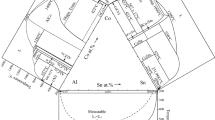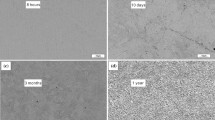Abstract
In this study, the changing trend of crystal-lattice constant and the influential factors of the stability of supersaturated solid solutions with various alloying additions in the Al–X (Zn, Mg, Cu) binary alloys were investigated. The samples were analyzed using X-ray diffraction (XRD), X-ray absorption fine structure (XAFS), and scanning electron microscope (SEM). It is found that the addition of Cu causes the largest change of crystal-lattice constant of the Al–xCu supersaturated solid solution binary alloy. The most dramatic change occurs in the initial stage of Cu addition. The change is stabilized thereafter. Also, at the same alloying element addition to the Al–X (X = Zn, Mg, Cu) binary alloys, the Al–xCu is the most unstable system. Influential factors of the stability include the lattice constant change and the type of alloying element. The larger the lattice constant changes, the more unstable the supersaturated solid solution is. The alloying element, easy to aggregate, often leads to the solid solution less stable.




Similar content being viewed by others
References
Wang ZT, Tian RZ. Handbook of Aluminum Alloy and Processing. Changsha: Central South University Press; 2004. 33.
Yan LM, Shen J, Li JP, Mao BP. Static softening behaviors of 7055 alloy during the interval time of multi-pass hot compression. Rare Met. 2013;32(3):241.
Couper MJ, Polmear IJ. Quench sensitivity in some rapidly solidified aluminum alloys. J Mater Sci lett. 1987;6:922.
Eskin DG. Decomposition of supersaturated solid solutions in Al–Cu–Mg–Si alloys. J Mater Sci. 2003;38(2):279.
Farber VM. Initial stages of decomposition of supersaturated solid solutions. Met Sci Heat Treat. 1995;37(10):391.
Chen DQ, Wang YS. Simulation of clusters formation in Al–Cu based and Al–Zn based alloys. J Mater Sci. 2005;40(13):3461.
Yu YN. Fundamentals of Science and Engineering. Beijing: Higher Education Press; 2008. 201.
Yuan XG, Ren LQ, Dong XL. The effect of ageing treatment on the α-Al lattice parameter of RS crystallite Al–Si alloys. J Liaoning Tech Univ (Nat Sci). 1999;18(3):269.
Wang XS, Nie B, Xie YC. Effect of heat-treatment institutions on conductivity of 7075 aluminum alloy. Light Alloy Fabr Technol. 2001;29(7):40.
Zhang XM, Liu SD, You JH, Zhang C, Zhang XY. Influence of aging on quench sensitivity effect of 7055 aluminum alloy. Chin J Nonferrous Met. 2007;17(2):394.
Starink MJ, Li XM. A model for the electrical conductivity of peak-aged and overaged Al–Zn–Mg–Cu alloys. Metall Mater Trans A. 2003;34(4):899.
Nagasaki S, Hirabayashi M. In: Liu A, editor. Binary Alloy Phase-Diagrams, vol. 29. Beijing: Metallurgical Industry Press; 2004. 29.
Kim Y, Chao YJ. Prediction of stable crack growth in surface cracked plate of aluminum 7050 alloy. Int J Fract. 2004;130(2):583.
Ferragut R, Dupasquier A, Lglesis MM, Macchi CE, Somoza A, Polmear IJ. Vacancy–solute aggregates in Al–Zn–Mg–(Cu, Ag). In: Proceedings of the 10th International Conference on Aluminium Alloys, Vancouver, 2006. 309.
Kratzer T, Gable BM, Nairn KM, Bastow TJ, Muddle BC, Hill AJ. The effect of alloying additins on vacancy behaviour in aluminum–copper alloys. In: Proceedings of the 10th international conference on aluminium alloys, Vancouver, 2006. 597.
Yoshiki Komiya, Shoichi Hirosawa, Tatsuo Sato. 3DAP analysis and computer simulation of nanocluster formation in the initial aging stage of Al–Zn alloys. In: Proceedings of the 10th international conference on aluminium alloys, Vancouver, 2006. 437.
Nie JF, Muddle BC, Aaronson HI, Ringer SP, Hirth JP. On the roles of clusters during intragranular nucleation in the absence of static defects. Metall Mater Trans A. 2002;33(6):1649.
Acknowledgments
This study was financially supported by the National Natural Science Foundation of China (No. 51274046).
Author information
Authors and Affiliations
Corresponding author
Rights and permissions
About this article
Cite this article
Zhang, ZH., Xiong, BQ., Zhu, BH. et al. Stability of supersaturated solid solution of quenched Al–X (X = Zn, Mg, Cu) binary alloys. Rare Met. 33, 139–143 (2014). https://doi.org/10.1007/s12598-014-0245-z
Received:
Revised:
Accepted:
Published:
Issue Date:
DOI: https://doi.org/10.1007/s12598-014-0245-z




